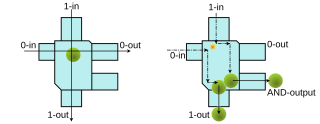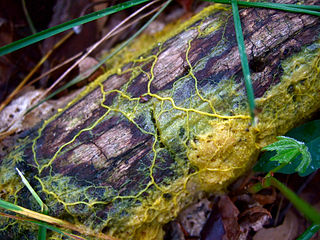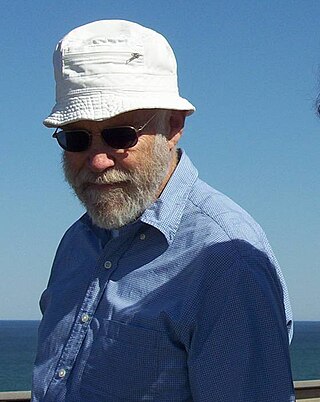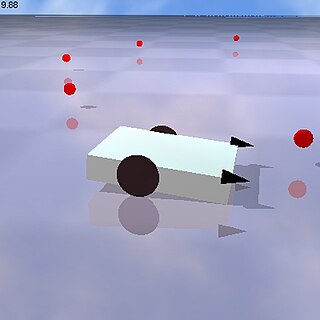Related Research Articles

Slime mold or slime mould is an informal name given to a polyphyletic assemblage of unrelated eukaryotic organisms in the Stramenopiles, Rhizaria, Discoba, Amoebozoa and Holomycota clades. Most are microscopic; those in the Myxogastria form larger plasmodial slime molds visible to the naked eye. The slime mold life cycle includes a free-living single-celled stage and the formation of spores. Spores are often produced in macroscopic multicellular or multinucleate fruiting bodies that may be formed through aggregation or fusion; aggregation is driven by chemical signals called acrasins. Slime molds contribute to the decomposition of dead vegetation; some are parasitic.

A cellular automaton is a discrete model of computation studied in automata theory. Cellular automata are also called cellular spaces, tessellation automata, homogeneous structures, cellular structures, tessellation structures, and iterative arrays. Cellular automata have found application in various areas, including physics, theoretical biology and microstructure modeling.

A Belousov–Zhabotinsky reaction, or BZ reaction, is one of a class of reactions that serve as a classical example of non-equilibrium thermodynamics, resulting in the establishment of a nonlinear chemical oscillator. The only common element in these oscillators is the inclusion of bromine and an acid. The reactions are important to theoretical chemistry in that they show that chemical reactions do not have to be dominated by equilibrium thermodynamic behavior. These reactions are far from equilibrium and remain so for a significant length of time and evolve chaotically. In this sense, they provide an interesting chemical model of nonequilibrium biological phenomena; as such, mathematical models and simulations of the BZ reactions themselves are of theoretical interest, showing phenomenon as noise-induced order.

Edward Fredkin was an American computer scientist, physicist and businessman who was an early pioneer of digital physics.
Blobotics is a term describing research into chemical-based computer processors based on ions rather than electrons. Andrew Adamatzky, a computer scientist at the University of the West of England, Bristol used the term in an article in New Scientist March 28, 2005.

A block cellular automaton or partitioning cellular automaton is a special kind of cellular automaton in which the lattice of cells is divided into non-overlapping blocks and the transition rule is applied to a whole block at a time rather than a single cell. Block cellular automata are useful for simulations of physical quantities, because it is straightforward to choose transition rules that obey physical constraints such as reversibility and conservation laws.
In computer science and machine learning, cellular neural networks (CNN) or cellular nonlinear networks (CNN) are a parallel computing paradigm similar to neural networks, with the difference that communication is allowed between neighbouring units only. Typical applications include image processing, analyzing 3D surfaces, solving partial differential equations, reducing non-visual problems to geometric maps, modelling biological vision and other sensory-motor organs.
Microbial intelligence is the intelligence shown by microorganisms. The concept encompasses complex adaptive behavior shown by single cells, and altruistic or cooperative behavior in populations of like or unlike cells mediated by chemical signalling that induces physiological or behavioral changes in cells and influences colony structures.

The science of pattern formation deals with the visible, (statistically) orderly outcomes of self-organization and the common principles behind similar patterns in nature.
Unconventional computing is computing by any of a wide range of new or unusual methods. It is also known as alternative computing.
A chemical computer, also called a reaction-diffusion computer, Belousov–Zhabotinsky (BZ) computer, or gooware computer, is an unconventional computer based on a semi-solid chemical "soup" where data are represented by varying concentrations of chemicals. The computations are performed by naturally occurring chemical reactions.

A billiard-ball computer, a type of conservative logic circuit, is an idealized model of a reversible mechanical computer based on Newtonian dynamics, proposed in 1982 by Edward Fredkin and Tommaso Toffoli. Instead of using electronic signals like a conventional computer, it relies on the motion of spherical billiard balls in a friction-free environment made of buffers against which the balls bounce perfectly. It was devised to investigate the relation between computation and reversible processes in physics.

Physarum polycephalum, an acellular slime mold or myxomycete popularly known as "the blob", is a protist with diverse cellular forms and broad geographic distribution. The “acellular” moniker derives from the plasmodial stage of the life cycle: the plasmodium is a bright yellow macroscopic multinucleate coenocyte shaped in a network of interlaced tubes. This stage of the life cycle, along with its preference for damp shady habitats, likely contributed to the original mischaracterization of the organism as a fungus. P. polycephalum is used as a model organism for research into motility, cellular differentiation, chemotaxis, cellular compatibility, and the cell cycle.
Natural computing, also called natural computation, is a terminology introduced to encompass three classes of methods: 1) those that take inspiration from nature for the development of novel problem-solving techniques; 2) those that are based on the use of computers to synthesize natural phenomena; and 3) those that employ natural materials to compute. The main fields of research that compose these three branches are artificial neural networks, evolutionary algorithms, swarm intelligence, artificial immune systems, fractal geometry, artificial life, DNA computing, and quantum computing, among others.

Lee Aaron Segel was an applied mathematician primarily at the Rensselaer Polytechnic Institute and the Weizmann Institute of Science. He is particularly known for his work in the spontaneous appearance of order in convection, slime molds and chemotaxis.
Norman H. Margolus is a Canadian-American physicist and computer scientist, known for his work on cellular automata and reversible computing. He is a research affiliate with the Computer Science and Artificial Intelligence Laboratory at the Massachusetts Institute of Technology.

A reversible cellular automaton is a cellular automaton in which every configuration has a unique predecessor. That is, it is a regular grid of cells, each containing a state drawn from a finite set of states, with a rule for updating all cells simultaneously based on the states of their neighbors, such that the previous state of any cell before an update can be determined uniquely from the updated states of all the cells. The time-reversed dynamics of a reversible cellular automaton can always be described by another cellular automaton rule, possibly on a much larger neighborhood.
Mictyris guinotae is a species of soldier crab of genus Mictyris, endemic to the Ryukyu Islands of Japan. They were named after Danièle Guinot, a professor at the Muséum national d'histoire naturelle in France, and were first treated as a separate species in a tribute volume to Guinot.

Artificial life is a field of study wherein researchers examine systems related to natural life, its processes, and its evolution, through the use of simulations with computer models, robotics, and biochemistry. The discipline was named by Christopher Langton, an American theoretical biologist, in 1986. In 1987 Langton organized the first conference on the field, in Los Alamos, New Mexico. There are three main kinds of alife, named for their approaches: soft, from software; hard, from hardware; and wet, from biochemistry. Artificial life researchers study traditional biology by trying to recreate aspects of biological phenomena.
The concept of biological computation proposes that living organisms perform computations, and that as such, abstract ideas of information and computation may be key to understanding biology. As a field, biological computation can include the study of the systems biology computations performed by biota the design of algorithms inspired by the computational methods of biota, the design and engineering of manufactured computational devices using synthetic biology components and computer methods for the analysis of biological data, elsewhere called computational biology or bioinformatics.
References
- ↑ "Future directions in computing: Chemical computing is an unconventional approach to computation that uses a "soup" where data is represented by different concentrations of chemicals", BBC News , 13 November 2007.
- ↑ Keim, Brandon (12 May 2011), "Video: Slime Mold Engineers the Motorways of Spain", Wired .
- ↑ "Railways and slime moulds: A life of slime. Network-engineering problems can be solved by surprisingly simple creatures", The Economist , 21 January 2010.
- ↑ Sterling, Bruce (31 August 2009), "It's a robot made of slime mold", Wired .
- ↑ Bland, Eric, "Plasmobot computer runs on slime mold: Powered by oat flakes, basic computer can perform different functions", MSNBC , archived from the original on 2012-07-18.
- ↑ Palmer, Jason (10 June 2011), "Slime mould prefers sedatives, say researchers: A simple life form known as a slime mould, used in unconventional computing, seems to have a taste for sedatives", BBC News .
- ↑ Aron, Jacob (12 April 2012). "Computers powered by swarms of crabs". New Scientist . Retrieved 2012-04-15.
- ↑ Solon, Olivia (14 April 2012). "Computer Built Using Swarms Of Soldier Crabs". Wired . Retrieved 2012-04-15.
- ↑ "Unconventional Computing Laboratory". uncomp.uwe.ac.uk. Retrieved 2012-04-15.
- ↑ Parallel Processing Letters Editorial Board, retrieved 2021-03-12.